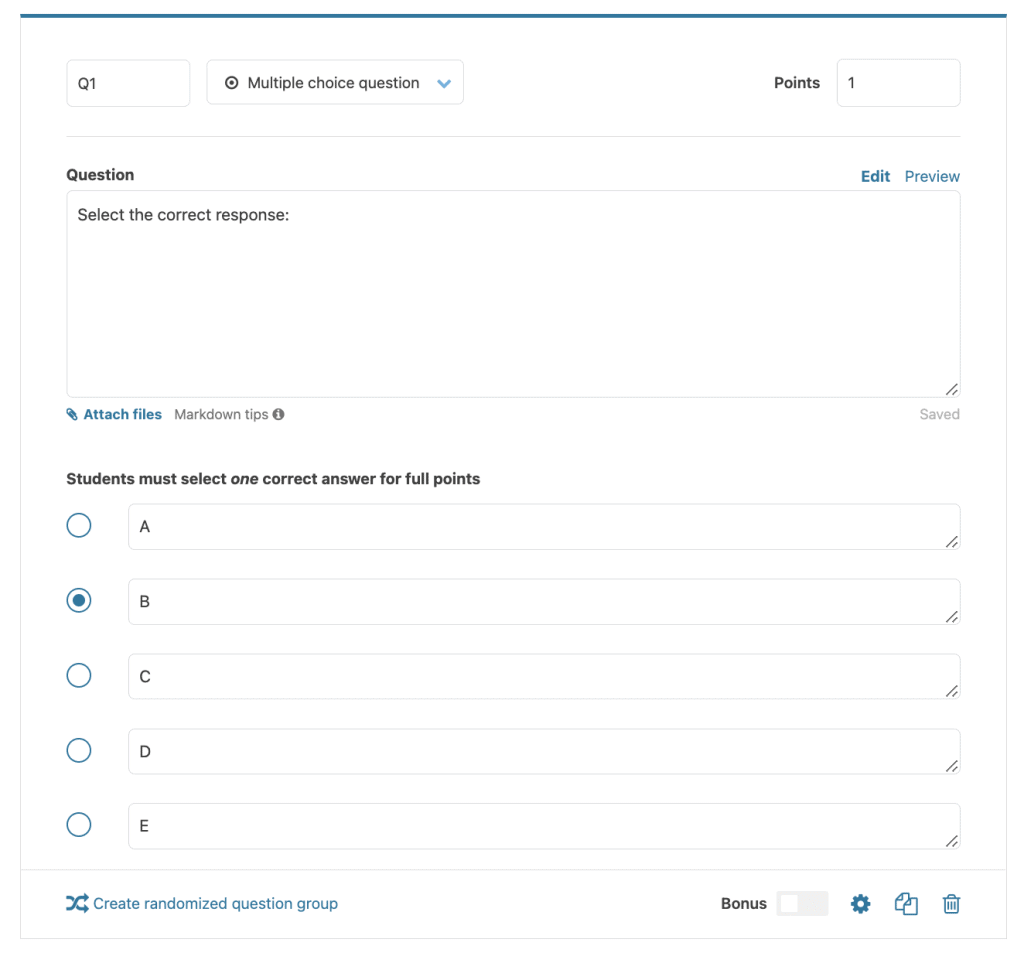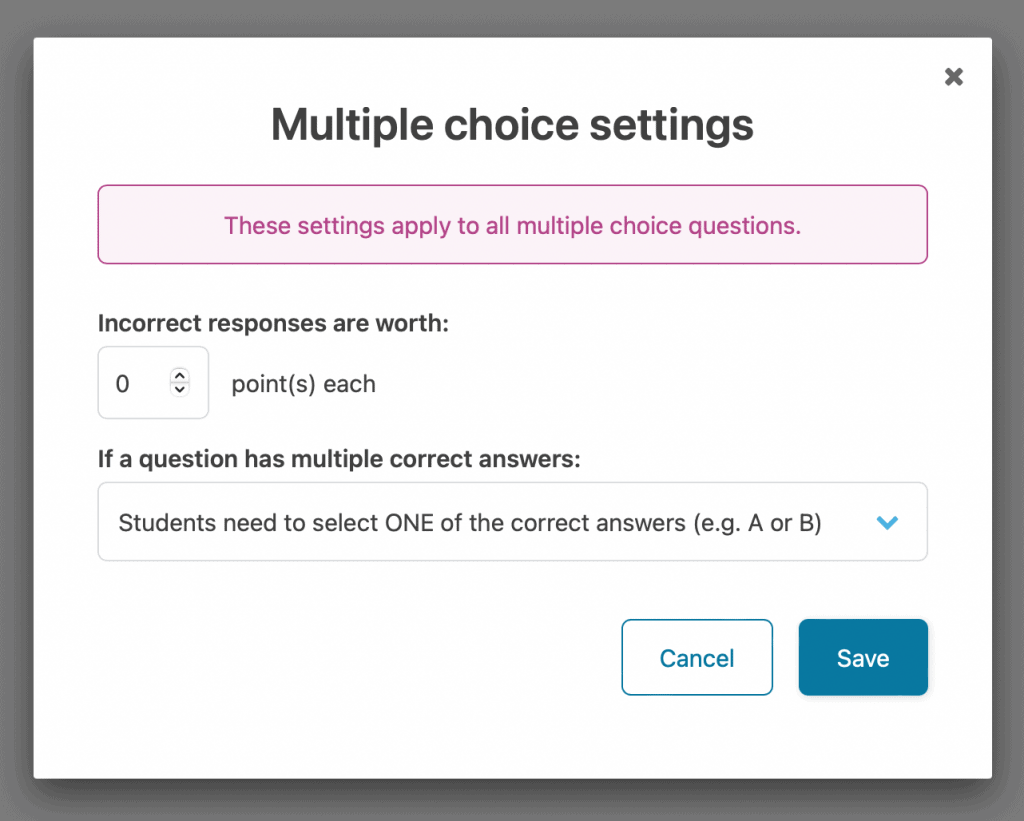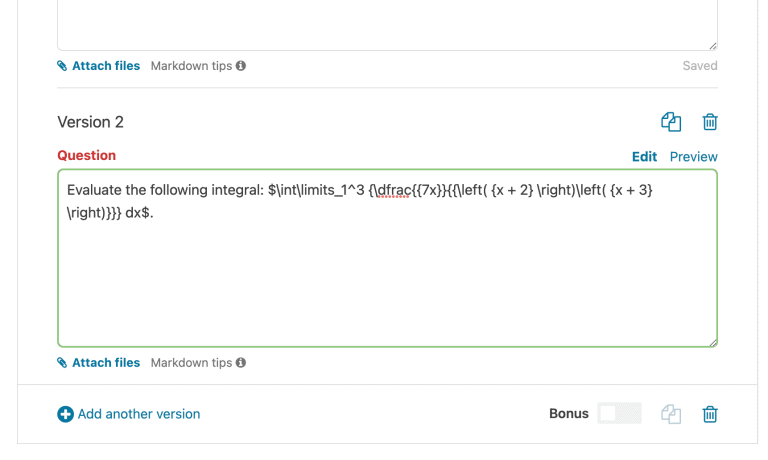Types of questions/responses
For each question, you’ll need to select which type of response students will submit. You have the choice between Image/PDF file, Text (with Markdown formatting) and Multiple choice. To learn more about how students interact with the different response types, see Completing and submitting an assessment.
Use the dropdown menu below the Question content to select the response type:
- Image/PDF file: With this option, a student is submitting their answers as a PDF, JPG or PNG file upload. If you or your students have used Crowdmark before, this will be the response format you’re used to. Files uploaded to this question type are displayed as images for grading and annotation.

- Text (with Markdown formatting): This response type allows the student to type their answer directly into the Crowdmark interface. They can use Markdown to include images, files, code snippets and links in their responses, as well as LaTeX for equations. Images will automatically be embedded in the text, while other files will show up as a link for the grader to view or download the file.
Note that images submitted via a Text response question are read-only and not able to be annotated. PDFs and other files attached to this question type are links to files only, and not displayed for annotation.
Bulk downloads of responses submitted in text, as well as any attached files, are available. See more information here.

- Multiple choice: Multiple choice allows for instructors to set questions with predefined responses for students to select from. An instructor can indicate one or multiple correct responses to a multiple choice question. Multiple choice responses are automatically graded by Crowdmark..
After you have selected Multiple choice from the dropdown menu, enter up to 5 response options in the fields provided. The fields support Markdown formatting. Use the checkboxes to the left of the response field to indicate the correct response option(s).

Multiple choice questions also have some additional settings, which you can access via the gear icon. Settings include removing points for incorrect answers, and how Crowdmark will handle multiple correct responses – do students need to match ONE of the answers to get their points, or ALL of them? These settings apply across the entire assessment.

Entering question content
To add questions, you can type question text directly into the Question content fields or copy and paste content from a Word or PDF document. If you paste question content, the formatting will not be maintained and you will have to re-format the text in Crowdmark.
Creating randomized question groups
All question types in an Assigned assessment allow for the creation of question versions. These versions will be randomly and evenly distributed amongst students’ assessments. To create a randomized question group:
- Enter the content for the first version of your question, then click Create randomized question group.

- Enter the content for the next version of your question. You can also click the Copy icon to duplicate the previous version. To continue adding versions, you can click Add another version.

- Once all the versions are complete, you can click outside the question editing area to collapse the versions and view them all as a group. To edit, you can click back on the question and the versions will expand.

Pro tip: When creating randomized groupings for Multiple choice questions, you can change the whole question, or simply reorder the responses in your versions.
Formatting
The Question content field supports Markdown, which allows you to change text formatting and to add links and images.
Some examples:
| Markdown | Formatted |
|---|---|
| *italics* | italics |
| **bold** | bold |
| ## Heading | Heading |
| [Purdue Owl](https://owl.english.purdue.edu/owl/) | Purdue Owl |
|  |  (with alt text “Crowdmark logo”) |
The Markdown guide contains a full list of formatting options.
Adding diagrams, images, or files
Click Attach files or drag and drop the files into the Question content field. The files will be uploaded to Crowdmark. The Markdown code will automatically be generated to either embed (images) or link to the files (PDF and other files).
Mathematical expressions
Comments in Crowdmark support LaTeX expressions using MathJax. This allows graders to write mathematical expressions. Inline mathematical expressions can be created by wrapping LaTeX with single dollar signs and displayed mathematical expressions can be created by wrapping with double dollar signs. We thank the developers of MathJax for making this possible.
Example:
$$zeta (s) = sum_{n=1}^infty frac{1}{n^s}$$
Chemical expressions
We are grateful to the developers of the mhchem package in MathJax for making this possible.
Example:
$$ce{SO4^2- + Ba^2+ -> BaSO4 v}$$